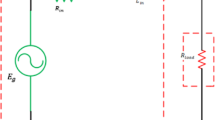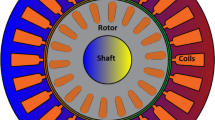Abstract
With the advancement of carbon material science, there have been attempts to apply carbon nanotubes in various engineering fields. In power electronics, application research has been conducted on using carbon nanotube (CNT) yarn in inductors, transformers, and motor windings, because CNT yarns show promising mechanical and electrical characteristics when compared with conventional conduction materials. This paper evaluates the feasibility of CNT yarn-based inductor applications with respect to higher-frequency power converter circuits, especially focusing on the ISM (Industry–Science–Medical) frequency range. Inductors are fabricated using two kinds of CNT yarns with different conductivity values. These inductors are compared with copper and lead coiled inductors, since they have a relatively high conductivity with respect to CNT yarns, and due to their popularity in the industry. The small-signal impedance data of each inductor according to the frequency variation are measured using a network analyzer, and the measurements were compared with a COMSOL simulation. One of the main results of this research is that the CNT yarn-based inductors were shown to have a better normalized AC resistance characteristic than the conventional conductor inductors, which have higher conductivity. It was found that CNT inductors have a similar AC resistance when compared to that of metallic conductors with nearly 1.85 times higher conductivity. A 100 W differential class-E resonant converter is implemented to test the inductors and to verify the small-signal measurement results. Efficiencies and thermal images are obtained at 6.78-MHz and 13.56-MHz ISM frequencies.











Similar content being viewed by others
References
Avouris, P., Appenzeller, J., Martel, R., Wind, S.J.: Carbon nanotube electronics. Proc. IEEE 91(11), 1772–1784 (2003)
P. G. Collins, M. Hersam, M. Arnold, R. Martel, Ph. Avouis: Current saturation and electrical breakdown in multiwalled carbon nanotubes. Phys. Rev. Lett. (2011)
K.M. Liew, C. H. Wong, X. Q. He, M.J. Tan: Thermal stability of single and multi-walled carbon nanotubes. Phys. Rev. (2005)
S. Berber, Y. K. Kwon, D. Tomanek: Unusually high thermal conductivity of carbon nanotubes. Phys. Rev. Lett. (2008)
Thess, A., Lee, R., Nikolaev, P., Dai, H., Petit, P., Robert, J., Xu, C., Lee, Y.H., Kim, S.G., Rinzler, A.G., Colbert, D.T., Scuseria, G.E., Tomanek, D., Fischer, J.E., Smalley, R.E.: Crystalline ropes of metallic carbon nanotubes. Science 273, 483–487 (1996)
Dehghani, S., Moravvej-Farshi, M.K.: Temperature dependence of electrical resistance of individual carbon nanotubes and carbon nanotubes network. Modern Phys. Lett. 26, 1250136 (2012)
Nieuwoudt, A., Massoud, Y.: Understanding the impact of inductance in carbon nanotube bunded for VLSI interconnect using scalable modeling techniques. IEEE Trans. Nanotechnol. 5, 758–765 (2006)
Li, H., Yin, W., Banerjee, K., Mao, J.: Circuit modeling and performance analysis of multi-walled carbon nanotube interconnects. IEEE Trans. Electron Devices 55, 1328–1337 (2008)
Li, H., Xu, C., Srivastava, N., Banerjee, K.: Carbon nanomaterials for next-generation interconnects and passives: physics, status, and prospects. IEEE Trans. Electron Devices 56, 1799–1821 (2009)
He, J., Guo, Z., Li, X.: Mechanism model and prediction method of common mode radiation for a nonisolated very-high-frequency DC–DC converter with cables. IEEE Trans. Power Electron. 35(10), 10227–10237 (2020). https://doi.org/10.1109/TPEL.2020.2978278
Feng, J., Li, Q., Lee, F.C., Fu, M.: LCCL-LC resonant converter and its soft switching realization for omnidirectional wireless power transfer systems. IEEE Trans. Power Electron. 36(4), 3828–3839 (2021). https://doi.org/10.1109/TPEL.2020.3024757
Zan, X., Avestruz, A.-T.: Isolated ultrafast gate driver with variable duty cycle for pulse and VHF power electronics. IEEE Trans. Power Electron. 35(12), 12678–12685 (2020). https://doi.org/10.1109/TPEL.2020.2999481
Rani, S., Sharma, Y.: Fabrication of binder-free and high energy density yarn supercapacitor for wearable electronics. IEEE Trans. Power Electron. 37(11), 13022–13029 (2022). https://doi.org/10.1109/TPEL.2022.3186958
Cesano, F., Uddin, M.J., Lozano, K., Zanetti, M., Scarano, D.: All-carbon conductors for electronic and electrical wiring applications. Front. Mater. (2020). https://doi.org/10.3389/fmats.2020.00219
Li, H., Banerjee, K.: High frequency analysis of carbon nanotube interconnects and implications for on-chip inductor design. IEEE Trans. Electron Devices 56(10), 2202–2214 (2009)
Kim, K.T., Manoharan, M.S., Tawifk, M.A., Lee, C.G., Park, J.H., Ahmed, A., Min, S.G., Park, J.H.: Skin effect-related AC resistance study in macroscopic scale carbon nanotube yarn applicable to high-power converter. IEEE Trans. Nanotechnol. 20, 417–424 (2021). https://doi.org/10.1109/TNANO.2021.3076472
Park, J.H., et al.: Proximity effect study of macroscopic-scale carbon nanotube fiber yarn in MHz region. IEEE Trans. Nanotechnol. 20, 803–809 (2021). https://doi.org/10.1109/TNANO.2021.3124210
Park, J.H., et al.: Thermal effect on carbon nanotube fiber high-ampacity conductors at high frequencies. IEEE Trans. Device Mater. Reliab. (2022). https://doi.org/10.1109/TDMR.2021.3129194
Tawfik, M.A., et al.: On using CNTFs-based wires for high frequency wireless power transfer charging systems. IEEE Trans. Nanotechnol. 20, 784–793 (2021). https://doi.org/10.1109/TNANO.2021.3119695
Ehab, M., Tawfik, M.A., Lee, C.-G., Ahmed, A., Park, J.-H.: Performance of the 100-μm diameter high conductivity CNT Fibers in MHz frequencies. IEEE Trans. Nanotechnol. (2022). https://doi.org/10.1109/TNANO.2022.3200640
Behabtu, N., Young, C.C., Tsentalovicch, D.E., Kleinerman, O., Wang, X., Ma, A.W.K., Rmram Bengio, E., ter Waarbeek, R.F., de Jong, J.J., Hoogerwerf, R.E., Fairchild, S.B., Ferguson, J.B., Maruyama, B., Kono, J., Talmon, Y., Conem, Y., Otto, M.J., Pasquali, M.: Strong, light, multifunctional fibers of carbon nanotubes with ultrahigh conductivity. Science 339(6116), 182–186 (2013)
Headrick, R.J., Tsentalovich, D.E., Berdegué, J., Bengio, E.A., Liberman, L., Kleinerman, O., Lucas, M.S., Talmon, Y., Pasquali, M.: Structure-property relations in carbon nanotube fibers by downscaling solution processing. Adv. Mater. (2018). https://doi.org/10.1002/adma.20170448
Taylor, L.W., Dewey, O.S., Headrick, R.J., Komatsu, N., Marquez Peraca, N., Wehmeyer, G., Kono, J., Pasquali, M.: Improved properties, increased production, and the path to broad adoption of carbon nanotube fibers. Carbon 171, 689–694 (2021)
Avouris, P., Appenzeller, J., Martel, R., Wind, S.J.: Carbon nanotube electronics. Proc IEEE 91(11), 1772–1784 (2003)
DexMat. 2021. Galvorn CNT Twisted Yarn 500 microns. [online] Available—87—https://store.dexmat.com/galvorn-cnt-twisted-yarn-500-microns/.
DexMat. 2021. Galvorn CNT-HS Twisted Yarn 500 microns. [online] Available— 87—https://store.dexmat.com/galvorn-cnt-hs-twisted-yarn-500-microns.
Kazimierczuk, M.: Class E zero-voltage-switching resonant inverter. In: Resonant Power Converters, 2nd edn. Wiley, New York (2011)
C. Steve, Cripps: “RF power Amplifiers” for Wireless Communications, Artech House, 1998
Steigerwald, R.L.: A comparison of half-bridge resonant converter topologies. IEEE Trans. Power Electron. 3(2), 174–182 (1988)
Acknowledgements
This work was supported by a National Research Foundation of Korean (NRF) Grant funded by the Korea government (MIST) (No. 2019R1A2C1084605).
Author information
Authors and Affiliations
Corresponding author
Rights and permissions
Springer Nature or its licensor (e.g. a society or other partner) holds exclusive rights to this article under a publishing agreement with the author(s) or other rightsholder(s); author self-archiving of the accepted manuscript version of this article is solely governed by the terms of such publishing agreement and applicable law.
About this article
Cite this article
Park, JH., Kim, KT., Lee, CG. et al. Performance evaluation of carbon nanotube yarn-based inductors for ISM-frequency band soft-switching converters. J. Power Electron. 23, 1778–1788 (2023). https://doi.org/10.1007/s43236-023-00693-1
Received:
Revised:
Accepted:
Published:
Issue Date:
DOI: https://doi.org/10.1007/s43236-023-00693-1




